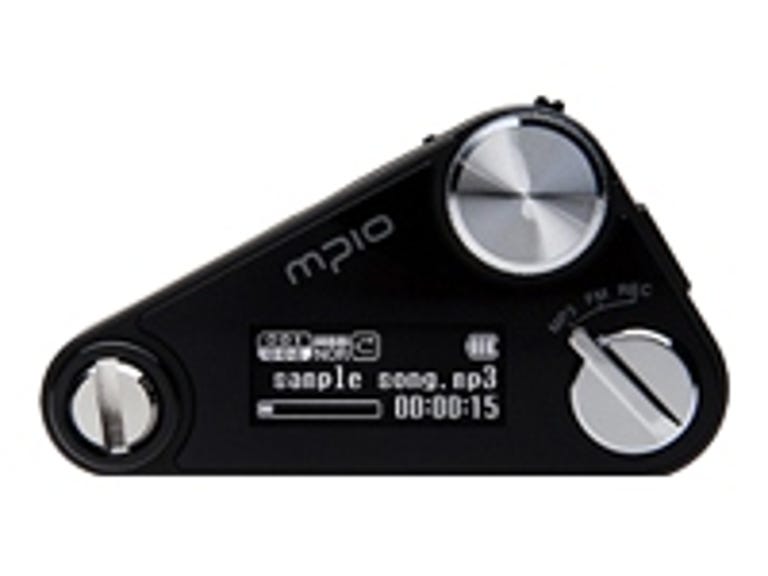The Good
The Bad
The Bottom Line
Design
The aesthetics of the MPIO FL500 are distinctive. With its oversize, metallic rotary controls and its triangular body, the player looks like a mashup of a '70s hi-fi receiver and the cars from the movie Tron. There is a sturdy, smooth metal clip on the back of the FL500 that can be detached by removing the large flathead bolt at the corner of the player. Removing the clip and bolt leaves a hole through which you can thread a lanyard (not supplied) if you're more inclined to wear your player around your neck.
Once you get the FL500 in your hand, the feel of the player's flimsy plastic construction betrays its promising good looks. Aside from the metal bolt and clip, the player and its two metallic dials are constructed from toylike plastic. Spinning the largest dial (volume control) feels more like the scroll wheel on your mouse than the smooth resistance of an analog hi-fi knob. Behind the volume dial, on the corner edge of the player, you'll find a switch controlling the transport functions (push to play or pause, left or right to scan or skip). Because both the volume wheel and these transport controls are located on the corner of this player, we found it very easy to bump them accidentally--especially when we placed the FL500 in our pockets. To be fair, the player is obviously designed to be worn, and a hold switch on the opposite edge of the player prevents the controls from misfiring.
We did find the dedicated mode selector switch on the front of the player to be an improvement compared to the way other MPIO players have handled switching modes via illegible menus or unmarked buttons. We also thought the menu button was intuitively placed, right between the mode selector and the transport controls on the side of the player. Unfortunately, one glaring design flaw is the FL500's flimsy, barely tethered rubber door covering its type-B mini USB 2.0 connection. We would rather they leave the door off altogether and just make the USB port flush with the case.
Predictably, the monochrome screen on the FL500 is as small, dim, and cluttered as the screen on the recently reviewed MPIO FY800. Other players in this category (such as the Philips GoGear 4010) suffer the same problem of striking a balance between battery life and a legible, well-lit screen. I can see the design-by-committee logic that would come to the conclusion that any screen is better than no screen at all. But I think it's safe to say that products such as Apple's iPod Shuffle are proving that when it comes to micro-size players, many American gadget consumers prefer lavishly produced design and ease of use over less-refined products capable of track display and added functionality.
Features
The MPIO FL500 does have some handy and useful functions that are absent from many of its competitors--though not quite as many as its closest competitor, the Creative Zen Nano Plus. Using the FL500's FM tuner was a cinch and gave us fair reception around the office as well as in the stairwell. Saving to one of its 20 FM presets required more than a few clicks through the FL500's menus. These same FM menus give you access to international FM bands in the event that you'll be using the player overseas. Its FM recording mode produced underwhelming results, even after choosing the FL500's highest-quality recording option. Voice recording was average as well but presented a surprising array of options such as voice-activated recording and gain control (also found on the MPIO FY800).
Another fun and surprising feature found in the FL500's system menu is a playback speed control setting, allowing you to speed up or slow down an audio file's playback speed without altering the audio's pitch. This time-stretching effect can be useful for reviewing and clarifying recorded speech or for the pure amusement of playing pop music at half-speed to check for demonic messages. The playback speed feature can be used along with the FL500's A/B loop feature to pick out specific segments of an audio file, loop them, then slow them down. On the downside, chances are slim that you'll remember how to find and use these features when you need them.
Internally, like the MPIO FY800, the FL500 supports MP3, WMA, and ASF file formats and can be switched between a Mac- and Windows-compatible MSC mode (allowing the device to show up as a USB hard drive) and a Windows-specific MTP mode that supports Windows Media Player. The FL500 also lacks support for playlists or ID3 tags. Instead, you'll have to sort all your music into a folder tree and use drag-and-drop transfer to organize your songs.
Performance
When set to flat, the MPIO FL500's sound quality held up to scrutiny when compared to that of players such as the Sansa e280R and the Cowon iAudio U3. We found the six EQ presets and the user-defined five-band preset useful in warming up the sound and creating more sparkle in the higher frequencies. Overall, the FL500 produced a consistent and rich sound that defied its size and budget build-quality. The earbuds included with the FL500 were not the worst we've heard, but we strongly urge users to upgrade them.
Our CNET Labs tested the MPIO FL500 and found it was able to last 15 hours on one charge--not bad, but not impressive when compared to less expensive players with more features, such as the Creative Zen Nano Plus, which is rated at around 19 hours.



